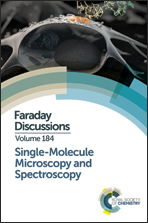Single molecule fluorescence resonance energy transfer scanning near-field optical microscopy: potentials and challenges
Abstract
A few years ago, single molecule Fluorescence Resonance Energy Transfer Scanning Near-Field Optical Microscope (FRET SNOM) images were demonstrated using CdSe semiconductor nanocrystal–dye molecules as donor–acceptor pairs. Corresponding experiments reveal the necessity to exploit much more photostable fluorescent centers for such an imaging technique to become a practically used tool. Here we report the results of our experiments attempting to use nitrogen vacancy (NV) color centers in nanodiamond (ND) crystals, which are claimed to be extremely photostable, for FRET SNOM. All attempts were unsuccessful, and as a plausible explanation we propose the absence (instability) of NV centers lying close enough to the ND border. We also report improvements in SNOM construction that are necessary for single molecule FRET SNOM imaging. In particular, we present the first topographical images of single strand DNA molecules obtained with fiber-based SNOM. The prospects of using rare earth ions in crystals, which are known to be extremely photostable, for single molecule FRET SNOM at room temperature and quantum informatics at liquid helium temperatures, where FRET is a coherent process, are also discussed.
- This article is part of the themed collection: Single-Molecule Microscopy and Spectroscopy

 Please wait while we load your content...
Please wait while we load your content...